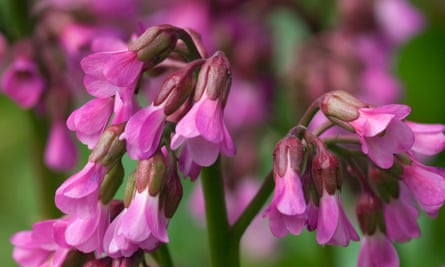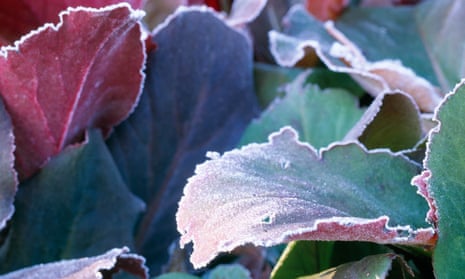The first hard nights of cold turn elephant ears into something else. Overnight they will blush from a glossy green into rich mahogany or deep plum wine. They will crackle with crimson and glow with cherry tints and hold these majestic colours all winter long until the first few really warm days of spring appear – then, like that, they will drop their winter colour and fade back to green. You might all but forget about them until, come spring, they unfurl into graceful nodding heads of magenta, pink or white flowers.

Elephant ears (bergenia species), have large, crinkle-edged, robust, polished-leather-looking leaves. That is, if you take care of them. Many people turn their noses up at bergenias as boring plants – I think that is partly because, if they are neglected, they can look rather tattered and dull. On top of that, those thick, fleshy leaves can provide a village for snails and slugs, particularly if the dead and dying are not cleared away. Despite being able to tolerate a wide range of soils, from damp to dry, those with heavy clay soils or moist conditions should probably stay away for this reason. However, if you have a dry, slightly neglected spot, perhaps under the dappled shade of deciduous tree or a bank, a slope or a corner of a courtyard garden where little rain gets in, then these are for you.

The best leaf colour comes from strong light in winter, so now is the time to find the spot where they will burst with colour from low suns. If the winter is mild you might be able to get them in now, or wait till early spring. They are perfect for path edges or a front garden. Plant with hardy shield ferns, such as Polystichum aculeatum, or the bronze tints of spurge, Euphorbia epithymoides, or accent with brilliant red cornus stems.
Make sure to mulch every autumn with well-rotted compost or leaf mould, as this will ensure that you get glossy, healthy leaves. A starved clump is a very poor sight, but they are quick to regain gloss if you add organic matter to the soil.
The late, great Beth Chatto was a huge fan, calling them the hostas of the dry garden, and her nursery stocks an impressive range. Bergenia ‘Eric Smith’ has bronze-tinted above and carmine red below that turn the deepest dark red in winter. B. ‘Beethoven’ goes the wine-rich plum and B. ‘Abenglut’ has bright maroon foliage over winter and brilliant magenta flowers in spring. For more compact gardens try B. ‘Wintermarchen’ in deep plum, or B. ‘Mrs Crawford’ goes rich plum with crimson tones and has stylish white flowers in spring for those who cannot abide pink.

Comments (…)
Sign in or create your Guardian account to join the discussion